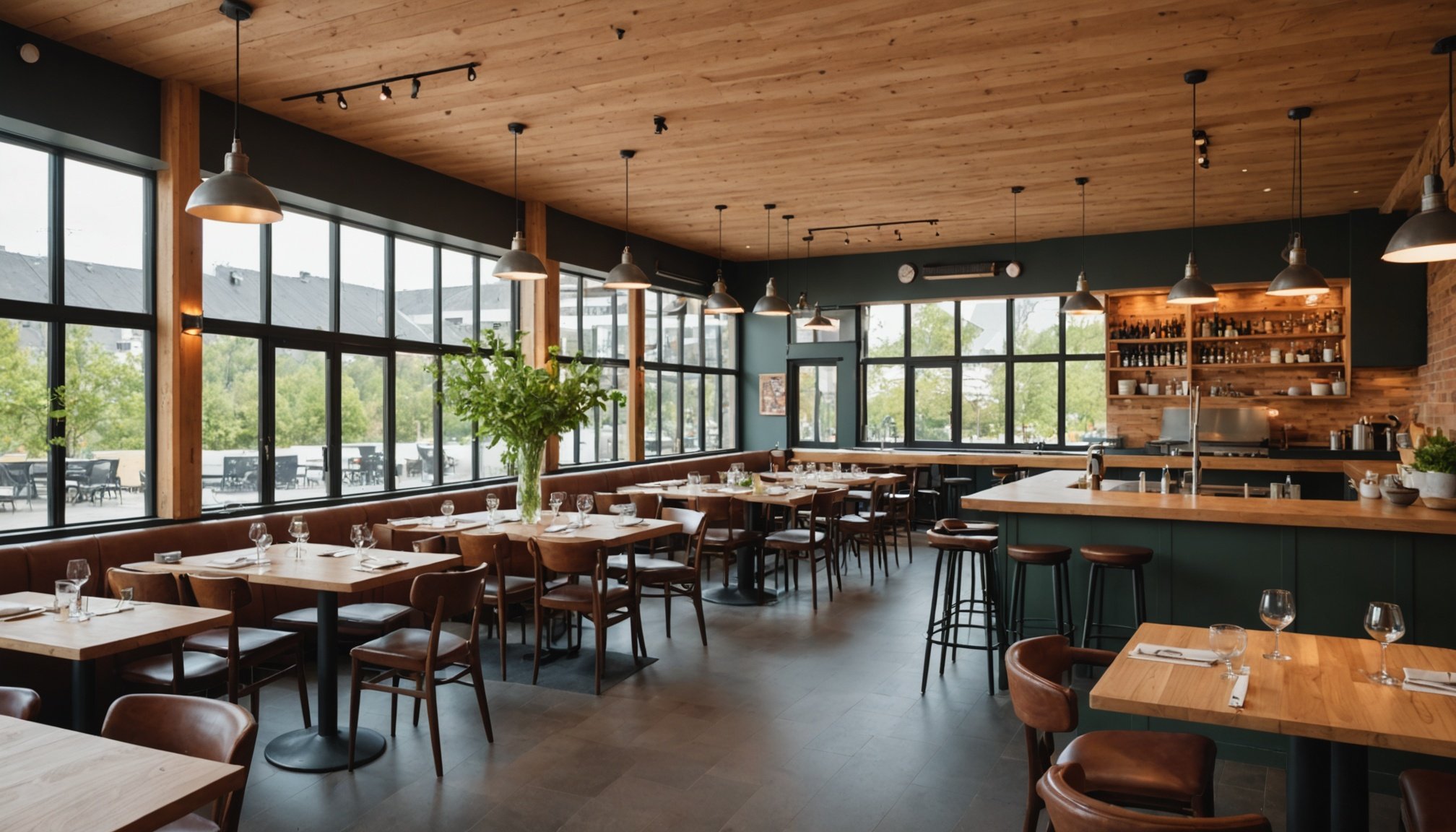Key Considerations for Designing a Sustainable Restaurant: A Guide to Eco-Friendly Spaces
In the modern restaurant industry, sustainability is no longer a trend, but a necessity. Creating a sustainable restaurant involves a multifaceted approach that encompasses everything from interior design and energy use to food sourcing and waste management. Here’s a comprehensive guide to help you design an eco-friendly restaurant that not only reduces its environmental impact but also enhances the dining experience for your customers.
Understanding the Importance of Sustainability in Restaurants
Sustainability in restaurants is about more than just reducing waste or using energy-efficient appliances; it's about creating a business model that benefits both the environment and your bottom line. Embracing sustainability can attract eco-conscious customers, reduce operational costs, and contribute to a healthier planet.
Have you seen this : How Lighting Sets the Mood: The Key Role in Enhancing the Atmosphere of Casual Dining Restaurants
"As restaurants seek to integrate Environmental, Social, and Governance (ESG) principles and sustainable solutions, they are not only reducing their environmental footprint but also improving their profitability and efficiency," notes an article from Restroworks.
Choosing the Right Theme and Interior Design
The theme and interior design of your restaurant are crucial in setting the tone for your sustainable practices. Here are some key considerations:
Have you seen this : Expert Insights: Crafting a Stunning and Functional Bar Layout for Maximum Impact
Selecting a Cohesive Theme
The theme of your restaurant should reflect your brand and guide your interior design choices. Whether you opt for a minimalist, rustic, or industrial theme, it should be consistent across all elements, including decor, menu design, and even staff uniforms.
"Selecting a cohesive theme is essential as it will guide the interior design and create consistency across all touchpoints," advises Zero Inch Interiors.
Importance of Lighting
Lighting is one of the most critical elements in restaurant design. It affects the ambiance, mood, and even the way food looks. Here are some types of lighting to consider:
- Task Lighting: Used for specific areas like kitchens or bar counters.
- Ambient Lighting: Sets the overall mood of the space.
- Accent Lighting: Highlights architectural features or artwork.
"Lighting can enhance the dining experience, making it cosy, intimate, or lively, depending on your restaurant’s theme," explains Bedrock Design.
Incorporating Greenery
Adding plants and natural elements can breathe life into your restaurant’s interior. Greenery not only enhances aesthetic appeal but also provides a calming effect, making the dining experience more enjoyable.
- Potted Plants: Easy to maintain and can be placed anywhere.
- Hanging Plants: Save floor space and add visual interest.
- Vertical Gardens: Great for smaller spaces and add a dramatic focal point.
Sustainable Materials and Furniture
The choice of materials and furniture is vital for creating an eco-friendly restaurant.
Ergonomic and Aesthetic Furniture
Choose furniture that is both comfortable and visually appealing. Tables, chairs, and seating arrangements should be ergonomically designed to ensure a pleasant dining experience.
"Comfort and aesthetics go hand in hand. Choose furniture that not only looks inviting but also provides comfort for diners," advises Bedrock Design.
Sustainable Materials
Use sustainable materials for your furniture and decor. This includes:
- Reclaimed Wood: Reduces the demand for new lumber.
- Recycled Metal: Minimizes waste and conserves natural resources.
- Eco-Friendly Fabrics: Choose fabrics that are made from sustainable materials or are recycled.
Energy Efficiency and Technology Integration
Energy efficiency is a key aspect of sustainable restaurant design.
Embracing Energy-Efficient Technologies
Invest in energy-efficient kitchen appliances, such as induction cooktops and energy-saving ovens. Replace traditional lighting with LED lights, which use less energy and have a longer lifespan.
"Smart thermostats can regulate heating and cooling more efficiently, ensuring that energy is not wasted when the restaurant is closed," suggests KwickPOS.
Technology Integration
Implement smart ordering systems, digital menus, and innovative audiovisual solutions to enhance the dining experience and reduce waste.
"Kitchen Display Systems (KDS) can eliminate the need for paper tickets, reduce paper waste, and contribute to environmental sustainability," notes Restroworks.
Sustainable Practices in Food Sourcing and Waste Management
Sustainable food sourcing and waste management are critical components of a green restaurant.
Supporting Local and Sustainable Suppliers
Sourcing ingredients from local and sustainable suppliers reduces the carbon footprint associated with long-distance transportation and supports the local economy.
"Local sourcing reduces the carbon emissions associated with long-distance transportation and helps support regional economies," explains KwickPOS.
Implementing Recycling and Composting Programs
Effective waste management is crucial for eco-friendly restaurants. Here are some best practices:
- Recycling Programs: Recycle materials such as cardboard, glass, plastics, and metals.
- Composting Programs: Compost food scraps and organic waste to create valuable compost.
- Waste Tracking Systems: Implement systems to track and reduce food waste.
"Implementing waste tracking systems and adopting practices like portion control, composting, and donating surplus food can help reduce waste," advises Restroworks.
Water Conservation and Cleaning Practices
Water conservation and the use of environmentally friendly cleaning products are essential for a sustainable restaurant.
Water Conservation Measures
Install low-flow faucets, efficient dishwashers, and water-saving appliances to reduce water consumption.
"Installing low-flow faucets and water-saving appliances can help conserve water," suggests KwickPOS.
Eco-Friendly Cleaning Products
Use cleaning products that are environmentally friendly and free from harsh chemicals.
"Eco-friendly cleaning products not only reduce environmental impact but also create a healthier working environment for your staff," notes Zero Inch Interiors.
Creating a Circular Economy in Your Restaurant
A circular economy approach focuses on reducing waste and the continuous use of resources.
Zero-Waste Initiatives
Implement zero-waste initiatives by creatively repurposing ingredients to minimize food waste and maximize efficiency.
"Zero-waste initiatives have gained traction, with chefs creatively repurposing ingredients to minimize food waste and maximize efficiency," explains an article on sustainable practices in menus.
Seasonal Menus
Offer seasonal menus that utilize locally sourced produce. This approach not only supports local farmers but also offers customers fresh, high-quality dishes.
"Seasonal menus that utilize locally sourced produce not only support local farmers but also offer customers fresh, high-quality dishes," advises KwickPOS.
Engaging Customers and Staff in Sustainability Practices
Engaging both customers and staff in sustainability practices is crucial for the success of your sustainable restaurant.
Educating Customers
Use interactive displays and mobile apps to inform customers about your sustainability efforts. This transparency helps build trust and loyalty.
"Interactive displays and mobile apps offer details on ingredient sources, energy consumption, and waste reduction initiatives. This level of transparency helps educate customers and also builds trust and loyalty," notes Restroworks.
Training Staff
Train your staff on proper waste segregation, energy-efficient practices, and the importance of sustainability. This ensures that your sustainability efforts are consistently implemented.
"Training staff on proper waste segregation ensures that recyclables and compostables are sorted correctly, maximizing the effectiveness of these programs," advises KwickPOS.
Case Studies: Successful Sustainable Restaurants
Here are some examples of restaurants that have successfully implemented sustainable practices:
Starbucks
Starbucks launched a pilot program to install solar panels on the rooftops of 100 of its stores. The program’s success led to a company-wide implementation, making Starbucks one of the largest restaurant chains to adopt solar power on a large scale.
Chipotle Mexican Grill
Chipotle launched a smart waste management system across its restaurants. This system sorts and tracks waste and converts food waste into energy. Within the first six months of implementation, waste was reduced by 35%.
Blue Hill at Stone Barns
Blue Hill at Stone Barns started using a digital platform to connect with local farmers and suppliers. This technology decreased the restaurant’s carbon footprint and allowed it to offer fresher, more sustainable food options to its customers.
Practical Tips for Implementing Sustainable Practices
Here are some practical tips to help you get started on your journey to creating a sustainable restaurant:
- Conduct an Energy Audit: Identify areas where energy can be saved and implement energy-efficient solutions.
- Implement Recycling Programs: Set up comprehensive recycling and composting programs to reduce waste.
- Source Locally: Partner with local farmers and suppliers to reduce carbon emissions from transportation.
- Use Sustainable Materials: Choose sustainable materials for your furniture and decor.
- Educate Your Staff: Train your staff on sustainability practices to ensure consistent implementation.
Creating a sustainable restaurant is a multifaceted endeavor that requires careful consideration of various aspects, from interior design and energy use to food sourcing and waste management. By incorporating these sustainable practices, you can reduce your restaurant’s environmental impact, attract eco-conscious customers, and contribute to a healthier planet.
"Sustainability in restaurants is not just a trend; it’s a commitment to a better future. By embracing sustainable practices, restaurants can reduce their environmental footprint, cut costs, and attract eco-minded customers," concludes Restroworks.
Table: Comparing Sustainable Practices in Different Restaurants
| Restaurant | Sustainable Practices | Environmental Impact Reduction |
|---|---|---|
| Starbucks | Installed solar panels on rooftops | Reduced energy consumption |
| Chipotle Mexican Grill | Implemented smart waste management system | Reduced waste by 35% |
| Blue Hill at Stone Barns | Used digital platform to connect with local farmers | Decreased carbon footprint |
| Sweetgreen | Transitioned to Energy Star-rated appliances | Reduced energy consumption |
| McDonald’s | Launched interactive displays showing sustainability efforts | Educated customers on sustainability |
By following these guidelines and examples, you can create a sustainable restaurant that not only benefits the environment but also enhances the dining experience for your customers.
Key Takeaways:
- Sustainable Design: Incorporate sustainable materials, energy-efficient technologies, and greenery into your restaurant design.
- Food Sourcing: Source ingredients from local and sustainable suppliers to reduce carbon emissions.
- Waste Management: Implement recycling and composting programs to minimize waste.
- Customer Engagement: Educate customers about your sustainability efforts to build trust and loyalty.
- Staff Training: Train staff on sustainability practices to ensure consistent implementation.
By making these considerations a part of your restaurant’s core operations, you can create a sustainable and successful business that benefits both your customers and the environment.











